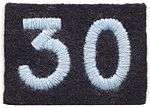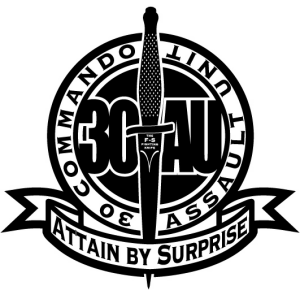No. 30 Commando
| 30 (Commando) Assault Unit | |
|---|---|
|
unit badge | |
| Active | 1942–1946 |
| Country |
|
| Branch | Royal Marines, Royal Navy, Army and attached civilian specialists. |
| Type | British Commandos |
| Role | Intelligence gathering |
| Size | 120 all ranks[1] |
| Part of | Combined Operations |
| Nickname(s) | Red Indians |
| Motto(s) | "Attain By Surprise" |
| Engagements | Second World War |
| Commanders | |
| Notable commanders | Lieutenant Commander Quintin Theodore Petroe Molesworth Riley[2] |
| Insignia | |
| 30 Assault Unit Shoulder Insignia |
 |
No. 30 Commando, from 1943 known as 30 Assault Unit, was a British Commando unit during the Second World War, originally formed to gather intelligence.
History
In September 1942, the Director of Naval Intelligence authorised the formation of the Special Intelligence Unit, composed of 33 (Royal Marines) Troop, 34 (Army) Troop, 35 (Royal Air Force) Troop and 36 (Royal Navy) Troop. The Special Intelligence Unit was later renamed 30 RN Commando (Special Engineering Unit), and was re-designated 30 Assault Unit in December 1943.[2] One of the key figures involved in the unit's organisation was Ian Fleming (later author of the James Bond novels). They were tasked to move ahead of advancing Allied forces, or to undertake covert infiltrations into enemy territory by land, sea or air, to capture much needed intelligence, in the form of codes, documents, equipment or enemy personnel.[2] They often worked closely with the Intelligence Corps' Field Security sections. Individual troops were present in all operational theatres and usually operated independently, gathering information from captured facilities.[2]
The unit was initially deployed for the first time during the Dieppe Raid in August 1942 in an unsuccessful secret attempt to capture an Enigma machine and related materials,[3] and then took part in the Operation Torch landings in November 1942. They landed to the west of Algiers at Sidi Ferruch on 8 November.[4] They had been provided with detailed maps and photographs of the area and on the outskirts of the city located the Italian naval headquarters. By the following day all the battle orders for the German and Italian fleets, current code books and other documents had been sent back to London.[4] The unit went on to serve in the Greek Islands, Norway, Pantelleria, Sicily, Italy, and Corsica.[2] In November 1943, they returned to the United Kingdom to prepare for the Allied invasion of German occupied Europe. Now called 30 Assault Unit, in June 1944 they took part in the Normandy landings, using the code names Woolforce and Pikeforce, troops landed on Juno beach and Utah beach, tasked to capture a German radar station at Douvres-la-Delivrande which held out until 17 June.[2] They later fought their way into Cherbourg. In July 1944 they were stationed at Rennes and Brest, and followed the Free French forces during the Liberation of Paris.[2] In September 1944, 30 Assault Unit began a series of mainly armed Jeep mounted operations in the Channel coast ports as they were captured by the Allies. By May 1945, Royal Marines from 30 Assault Unit had captured the German Naval Base at Bremen, Germany.[2]
What they did in Germany as the Allies advanced remains a fairly well kept secret. Some of the few documents that are open to the public do reveal that they targeted Nazi scientists.[5][6] At least one such scientist was captured by a "Field Team" of 30 Assault Unit and then reported as "surrendering" with Wernher von Braun and Walter Dornberger in Bavaria.[7]
The British army provided a small number of troops for this unit and these were designated 34 troop. The army unit operated mainly in the Italian & Balkan theatre. Unfortunately there is very little information available on their missions as it would seem they are still subject to Government restrictions. Most notable (or infamous) of these men was Johnny Ramensky, a Lithuanian-descended safe-cracker from Scotland who was sent to the unit to blow open safes.[8] These units were normally inserted by parachute behind enemy lines.
A 30 Assault Unit Royal Marines detachment was sent to the Far East in 1945, but the Japanese surrender precluded operations. Subsequent activities in Singapore, Indo-China and Hong Kong eventually provided much useful intelligence. 30 Assault Unit was finally disbanded in 1946.[2]
Post war
30 Assault Unit was disbanded in 1946, however in 2010 the Royal Marines formed 30 Commando Information Exploitation Group (30 Cdo IXG RM) which carries on the history of 30 Assault Unit.[9]
In 2013, 30 Commando Information Exploitation Group were granted the freedom of Littlehampton, West Sussex, in honour of the original unit being based in the town during the Second World War.[10][11]
Organisation
By 1945 30 Assault Unit consisted of HQ Troop; A, B and X Troops; a mobile RN signals unit, and a RN medical unit.
In fiction
- The film Age of Heroes is very loosely based on the real 30 Assault Unit.
Notable members
- Johnny Ramensky, career criminal and noted safe blower
- Sir Charles Wheeler, broadcaster and journalist
- Patrick Dalzel-Job, British Naval Intelligence Officer and Commando
References
Notes
- ↑ Ladd, p.353
- 1 2 3 4 5 6 7 8 9 "History of 30 Assault Unit 1942-1946". Liddell Hart Centre for Military Archives, King's College London. Retrieved 2 June 2010.
- ↑ Ogrodnik, Irene. "Breaking German codes real reason for 1942 Dieppe raid: historian." Archived 24 October 2012 at the Wayback Machine. Global News, 9 August 2012. Retrieved: 13 August 2012.
- 1 2 Haining, p.33
- ↑ Nutting, David (2003). Attain by Surprise. Colver. ISBN 0-9526257-2-5.
- ↑ Appendix 1 (Part 5): History of 30 Commando (later called 30 Assault Unit and 30 Advanced Unit also known as Special Engineering Unit). Admiralty SW. 1946 [released 1997]. ADM 223/214.
- ↑ Bower, Tom (1997). The Paperclip Conspiracy. Paladin. ISBN 0-586-08686-2.
- ↑ "Feature: Gentle Johnny". The National Archives of Scotland. Retrieved 15 September 2016.
- ↑ "UK Royal Marines Rename Information Unit". International Defence Review. London: Janes. June 2010. p. 8.
We are immensely proud to be able to carry on the history of 30 Commando
- ↑ "Littlehampton grants town freedom to James Bond unit". BBC. 5 October 2013. Retrieved 17 February 2014.
- ↑ "Fleming's Red Indians special Royal Marine Commando unit". Littlehampton Gazette. 31 July 2013. Retrieved 17 February 2014.
Bibliography
- Chappell, Mike (1996). Army Commandos 1940–45. London: Osprey Publishing. ISBN 1-85532-579-9.
- Haining, Peter (2007). The Mystery of Rommel's Gold: The Search for the Legendary Nazi Treasure. Avana Books. ISBN 1-84486-053-1.
- Ladd, James (1980). The Royal Marines 1919–1980. London: Jane's. ISBN 978-0-7106-0011-0.
- Moreman, Timothy (2006). British Commandos 1940–46. Osprey Publishing. ISBN 1-84176-986-X.
Further reading
- Hugill, J. A. C. (1946). "The Hazard Mesh". London: Hurst & Blackett. OCLC 14636090.
- Riley, J. P. (1989). "From Pole to Pole". Bluntisham Books. ISBN 1-871999-02-2.
- Dalzel-Job, Patrick (1991). "Arctic Snow to Dust of Normandy". Barnsley: Pen and Sword Military Books. ISBN 1-84415-238-3.
- Rankin, Nicholas (2011). "Ian Fleming's Commandos: The Story of the Legendary 30 Assault Unit". London: Oxford University Press. ISBN 978-0-19-978282-6.
- Hampshire, A. Cecil (1978). The Secret Navies. London: W. Kimber. ISBN 0-71830-195-1.
